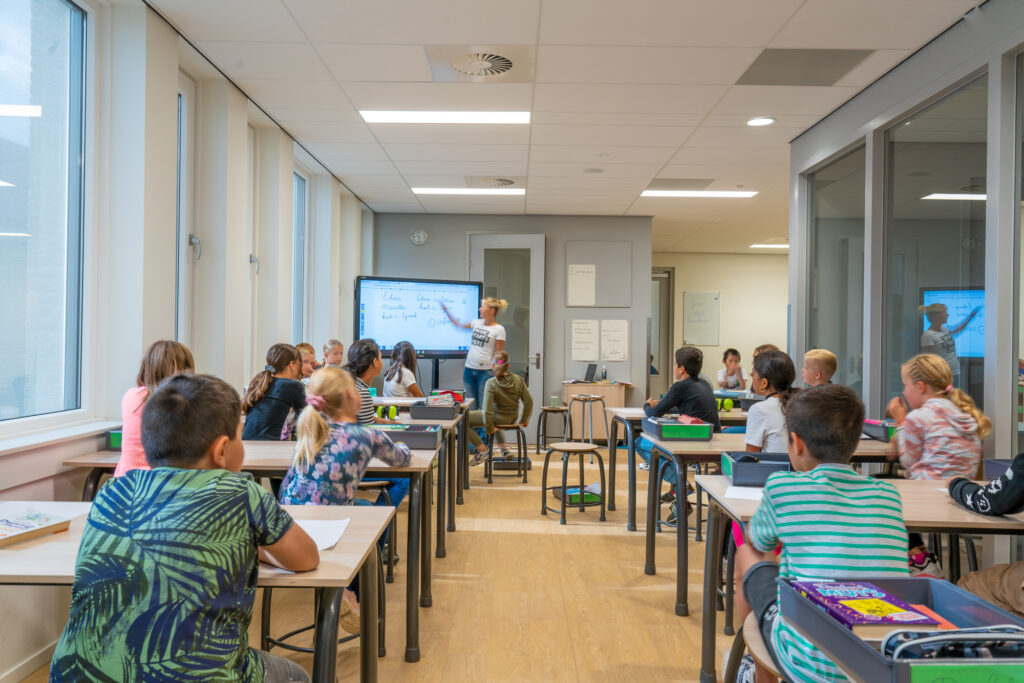The Dutch education system looks incredibly confusing from the outside — yet it’s considered to be among the best in the world.
But where it gets tricky is the multiple different paths with twists and turns towards graduation and higher education.
After living in the Netherlands for almost 14 years and navigating the high school and university rules, I’m here to take you back to school to understand the Dutch education system.
- The Dutch preschool (peuterschool)
- Primary education in the Netherlands
- Secondary education in the Netherlands
- Universities and vocational education in the Netherlands
- Terms and school holidays in the Netherlands
- The Dutch education system’s key terms
- The Dutch education system: Frequently asked questions
The Dutch preschool (peuterschool)
Let’s start from the very beginning. In the Netherlands, school is mandatory for children from the ages of five to 16.
However, many parents choose to enrol their children in preschool even earlier.

There are two main types of Dutch preschool, daycare (kinderdagverblijf) and kindergarten (peuterspeelzaal).
Dutch daycare (kinderdagverblijf)
Dutch daycares take care of infants and children up to four years old during the typical hours of a working day.

This is an ideal option for most working families, and some centres even offer out-of-hours and half-day care for children.
Dutch part-time preschool (peuterspeelzaal)
There is also the option to enrol your child at a part-time preschool from the age of two until four years.
Here, children attend school for three to five half-days per week, depending on the preschool.
Tip: Parents can usually claim childcare allowance (kinderopvangtoeslag) on daycare and kindergarten costs for their child.
All parents also receive the kinderbijslag (child benefit), which covers the general costs of having a child.
Some international parents can apply to receive the kinderbonden (child budget) to pay for other necessities.
Primary education in the Netherlands
Once a child reaches the age of four, they are allowed to start going to Dutch primary school (basisschool).
Dutch primary school has eight levels, called groepen (grades). They range from age four (Groep1) to 12 (Groep 8), including two years of kindergarten at the beginning of primary school.
| Age | The Netherlands | USA | UK | Australia |
| 2-3 | Kindergarten | – | – | – |
| 3-4 | Kindergarten | Pre-kindergarten | Foundation 1 | – |
| 4-5 | Groep 1 | Pre-kindergarten | Foundation 2 | Kindergarten |
| 5-6 | Groep 2 | Kindergarten | Year 1 | Pre-primary/Prep |
| 6-7 | Groep 3 | Grade 1 | Year 2 | Year 1 |
| 7-8 | Groep 4 | Grade 2 | Year 3 | Year 2 |
| 8-9 | Groep 5 | Grade 3 | Year 4 | Year 3 |
| 9-10 | Groep 6 | Grade 4 | Year 5 | Year 4 |
| 10-11 | Groep 7 | Grade 5 | Year 6 | Year 5 |
| 11-12 | Groep 8 | Grade 6 | Year 7 | Year 6 |
Compulsory education begins on the first day of the new month after the child turns five (Groep 2 in Dutch primary).
For example, if your child turns five on October 12, they’re required to start Groep 2 on the first school day in November of the same year.

Most Dutchies send their children to public schools and are taught entirely in Dutch.
This is a great option if you plan to stay in the Netherlands, but your child generally needs to have a basic level of Dutch first, especially if they’re older.
READ MORE | Should I enrol my child in a Dutch school? 6 factors to help you decide (from an expert)
Luckily, there are international transition schools (internationale schakelklassen) tailored to help children who have just arrived in the Netherlands transition to a Dutch school.

You can also send your kids to a bilingual school, which teaches children in English for part of the day.
Finally, there are also international schools that teach in other languages (including English, German, and French). These tend to follow international curricula.
READ MORE | 5 reasons to send your child to an international school in the Netherlands
Secondary education in the Netherlands
At the end of Group 8, or when a child is approximately 12 years old, they begin secondary school (middelbare school).
If your child is in a Dutch school, they will receive advice from their teacher on which of three education streams they should enter: VMBO, HAVO, or VWO.

This choice informs which unique secondary school programmes students will follow, which will later affect whether they can eventually pursue vocational training, professional education, or research education in the Netherlands.
VMBO (Pre-vocational secondary education)
VMBO (voorbereidend middelbaar beroepsonderwijs) is a four-year vocational stream that focuses on practical skills and knowledge.
It has two levels of qualification depending on whether the student wants to focus on vocational training or theoretical education.
Students complete the VMBO track at the age of 16, which eventually leads to further vocational training (middelbaar beroepsonderwijs, or MBO).
HAVO (Senior general secondary education)
HAVO (hoger algemeen voortgezet onderwijs) is a five-year high school stream that prepares students from the ages of 12 to 17 for higher professional education.

Completing a HAVO diploma allows students to study at a university of applied sciences (hogeschool) and follow a higher professional education programme (hoger beroepsonderwijs or HBO).
VWO (University preparatory education)
VWO (voorbereidend wetenschappelijk onderwijs) is a six-year high school programme for students who intend to pursue a bachelor’s degree at a research university (wetenschappelijk onderwijs, or WO).

This stream is the most theoretically-oriented programme for students aged 12 to 18 and is divided into two main programmes: atheneum and gymnasium.
The programmes are nearly identical, except that Latin and/or Greek language studies are compulsory in the gymnasium programme.
Universities and vocational education in the Netherlands
After secondary education, the Dutch education system also has three main routes for education: MBO, HBO, or WO.
Students who attended HAVO or WVO schools can choose one of the Dutch university options (HBO or WO), while students who attended a VMBO in high school are limited to MBOs.
READ MORE | Studying in the Netherlands: the ultimate guide
Types of Dutch universities
Dutch university education is divided into two different kinds of university institutions and study programmes: HBO and WO.
The two types of universities offer different kinds of programmes.
HBO (higher professional education)
HBO universities (hoger beroepsonderwijs) focus on providing specialised professional training for a specific profession.

Students spend most of their time learning practical skills for their chosen field and typically have an internship during the course of their study for up to a whole year.
HBO degrees are typically four years long and are most often followed by people who completed a HAVO or VWO programme in high school.
WO (scientific education)
WO universities (wetenschappelijk onderwijs) are more focused on academia compared to HBO universities.

Students are likely to conduct more research and work on theory-based projects instead of developing professional skills. Many WO universities carve out time for students to do internships, but they often have to choose between this and a minor or an exchange abroad.
Admission to higher education
Most HBO and WO universities admit students to courses if they graduate with a high school diploma.
For courses taught in English instead of Dutch, they’ll often ask students to provide proof that they speak English at a high enough level to take the programmes.

Some study programmes also require a certain grade in specialist subjects like maths.
If in doubt, students should refer to the study programme admissions page to find out the exact requirements for admission.
Credit system and degrees
HBO and WO study programmes use the European Credit Transfer System (ECTS), with one credit representing 28 hours of work. Students usually attain 60 credits within the standard academic year.

HBO bachelor programmes last up to four years (for a total of 240 ECs), while WO bachelor programmes are usually only three years (180 ECs). A master’s degree programme lasts between a year (60 ECs) and two years (120 ECs).
MBO (Middle-level applied education)
VMBO students continue with their vocational education in a vocational school called an MBO.
MBO education (middelbare beroepsonderwijs) prepares students for skilled trades and trained occupations such as mechanics and plumbers to nursing assistants and franchise managers.

There are four levels of MBO education, which lead to four job qualifications depending on the different levels of training.
- Level 1: assistant training (entreeopleiding)
- Level 2: basic vocational training (basisberoepsopleiding)
- Level 3: professional training (vakopleiding)
- Level 4: middle-management training (middenkaderopleiding)
Each level lasts a different amount of time and requires different amounts of training and experience hours during the programme.
Terms and school holidays in the Netherlands
You may know Dutchies for their overly organised agendas and bureaucracy — and you can definitely see it with their school terms and holidays.
Holidays in the Netherlands are generally divided by region (North, Central, and South) so that the entire country doesn’t go on holiday at the same time.

The dates always include primary, secondary, and special schools, but universities and individual schools might have slight deviations from the yearly calendar.
We suggest double-checking dates with the school just to make sure your holiday plans don’t clash.
It’s also important to note that the Netherlands has compulsory school attendance rules (leerplicht). This means that children must attend school full-time and can only miss school if they’re exempted (for example, if the child gets sick or if there’s a death in the family). If you break these attendance rules, you could get fined.
The Dutch education system’s key terms
Lost in translation or struggling with the acronyms? Here are the key terms to remember.
| Dutch | English | Meaning |
| Peuterschool | Pre-school | School for children under the mandatory schooling age in the Netherlands. |
| Kinderdagverblijf | Daycare | Daytime care for children between the ages of zero and four years during typical working hours in the day. |
| Kleuterschool | Kindergarten | A type of pre-school where children ages two to four can learn through socialisation with other children. |
| Basisschool | Primary school | Mandatory school for children between the ages of five and 12. |
| International schakelklas (ISK) | International transition school | A class in primary and early secondary school tailored to help international students prepare for going to a Dutch school. |
| Groepen | Grades/Years | Year group divisions in a Dutch school. There are eight mandatory groups in primary school, and between four and six groups depending on the secondary school programme you do. |
| Middelbare school | Secondary school | Mandatory school for children from the age of 12 until 16 to 18. |
| Voorbereidend middelbare beroepsonderwijs (VMBO) | Pre-vocational secondary education | A four-year secondary school programme focusing on practical skills and knowledge. |
| Hoger algemeen voortgezet onderwijs (HAVO) | Senior general secondary education | A five-year secondary school programme focusing on a mix of practical skills and theoretical knowledge. |
| Voorbereidend weteschappelijk onderwijs (VWO) | University preparatory education | A six-year secondary school programme focused on preparing students for a scientific university education. |
| Middelbare beroepsonderwijs (MBO) | Middle-level applied education | Vocational education focused on giving students the practical skills and theoretical knowledge for a wide range of trade occupations. |
| Hoger beroepsonderwijs (HBO) | Higher professional education | University education focused on providing a mix of theoretical and practical training for professions. |
| Wetenschappelijk onderwijs (WO) | Scientific education | University education focused on academic research and training. |
| Kinderopvangtoeslag | Childcare allowance | A grant given to parents to cover the cost of childcare in the Netherlands. |
| Kinderbijslag | Child benefit | A grant given to parents to cover the general cost of having a child in the Netherlands. |
| Kinderbonden | Child budget | A grant given to parents to pay for other necessities of the child, like education materials, diapers, etc. |
While the Dutch education system has plenty of levels and branches, once you get the hang of all those acronyms, it really starts to make sense!
Did you go to school in the Netherlands? Tell us about it in the comments below.
The Dutch education system: Frequently asked questions
What is the age range for students in secondary school in the Netherlands?
Mandatory secondary education in the Netherlands starts at 12 years old and last until 16 years old.
You can continue your secondary education until you’re 18 years old before you go to university, depending on the education programme you choose.
What kinds of secondary education are there in the Netherlands?
There are three main types of secondary education in the Netherlands: VMBO (pre-vocational education), HAVO (pre-hogeschool education), and VWO (pre-university education).
What kinds of education are there after high school in the Netherlands?
There are three main types of education in the Netherlands after high school: MBO (focused on vocational training), HBO (focused on higher professional education), and WO (focused on research and academia).
What is the equivalent of VWO in the United States and the United Kingdom?
VWO education in the Netherlands is equivalent to the Advanced Placement program (AP) in the United States, A-Levels in the United Kingdom, and the International Baccalaureate (IB) in international schools.
These programmes generally have similar levels and content but last different periods of time.
